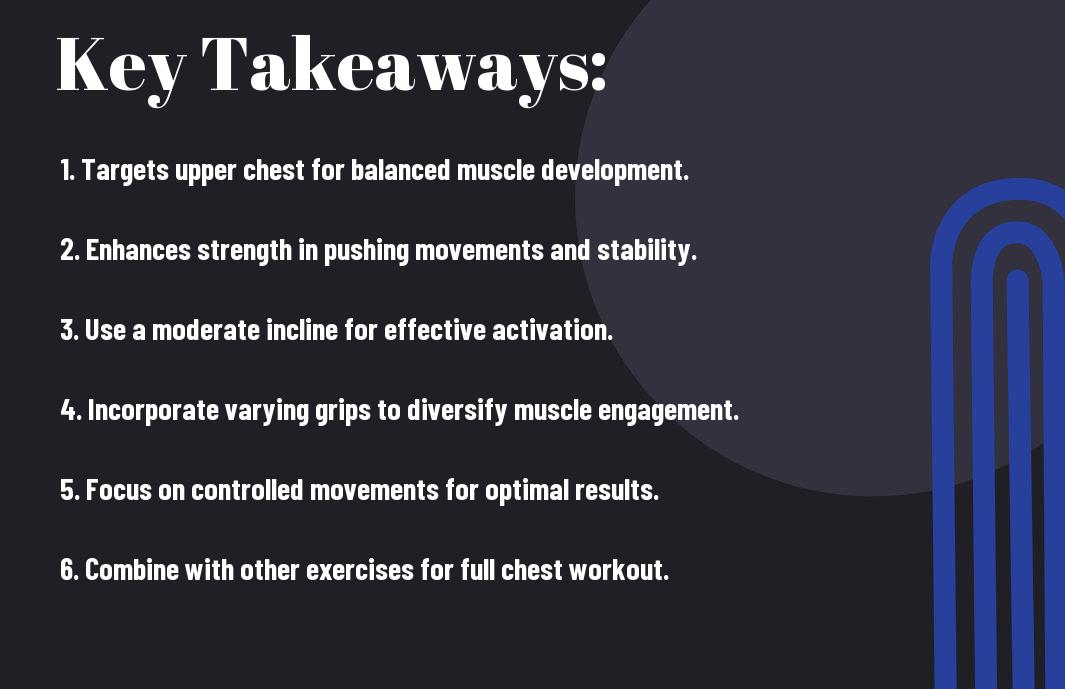Most fitness enthusiasts understand the importance of a well-defined upper chest for a balanced physique. The Incline Dumbbell Bench Press targets the upper pectoral muscles, helping you create that sought-after shape and strength. By incorporating this exercise into your routine, you can enhance your upper chest development while also engaging your shoulders and triceps. This guide will provide you with crucial tips and techniques to maximize your results and ensure proper form for optimal gains.

Understanding the Incline DB Bench Press
The Incline Dumbbell Bench Press is a powerful upper body exercise that specifically targets your upper chest muscles. This variation of the traditional bench press adds an incline, allowing for a greater range of motion and more focused muscle engagement. By incorporating this exercise into your routine, you can enhance your overall chest development. For step-by-step guidance, check out How to Incline Dumbbell Press.
Benefits for Upper Chest
On top of building muscle, the Incline DB Bench Press improves your overall upper body strength and stability. It helps you develop a fuller, more aesthetically pleasing upper chest, which can enhance your physique and boost your confidence. This exercise also engages your shoulders and triceps, making it a well-rounded addition to your workout routine.
Muscle Groups Targeted
Incline Dumbbell Bench Press primarily targets your upper pectorals. The incline angle shifts focus from the middle and lower chest to the upper region, improving that section’s definition and size. Additionally, your deltoids and triceps are engaged, providing a comprehensive upper body workout.
At the same time, the exercise engages stabilizing muscles, including your core, to maintain balance throughout the movement. This synergy not only maximizes muscle gain but also builds functional strength, which is beneficial for everyday activities and other fitness endeavors. By targeting multiple muscle groups, you ensure that your workouts are efficient and effective.

Proper Technique
It is vital to maintain proper technique during the incline dumbbell bench press to ensure safety and maximize muscle engagement. Start by positioning yourself correctly on the bench, setting your feet firmly on the ground. Your grip should be neutral, and elbows should be at a 45-degree angle relative to your torso. This form not only protects your shoulders but also emphasizes your upper chest development.
Setup and Positioning
Among the necessary steps for a successful incline dumbbell bench press is the correct setup and positioning. Begin by adjusting the bench to an angle of approximately 30 to 45 degrees. Sit on the bench with your feet flat on the ground, ensuring your back maintains contact with the support. Hold the dumbbells at shoulder height with your palms facing forward, ready to push upwards.
Movement Execution
After you are set up, initiate the movement by pressing the dumbbells upward. Focus on maintaining control throughout the lift, avoiding any jerky motions that may lead to injuries.
Hence, as you press the weights, ensure that your elbows are at an appropriate angle and your wrists remain aligned to prevent strain. Exhale during the upward phase, fully extending your arms without locking your elbows, then inhale as you lower the dumbbells back to the starting position. This controlled movement not only aids in muscle growth but also enhances overall stability during your workout.
Common Mistakes
After starting your incline DB bench press journey, it's vital to be aware of common mistakes that can hinder your progress. One major error is ignoring proper setup and alignment, which can lead to ineffective targeting of the upper chest muscles. For insights on whether incline exercises actually target (or develop) upper pecs, refer to expert discussions.
Incorrect Form
Common issues with form include arching your back excessively or raising your shoulders too high. This not only decreases the effectiveness of the exercise but can also increase your risk of injury.
Weight Selection
Among the mistakes you might make is choosing the wrong weight for your incline DB bench press. Using weights that are too heavy can compromise your form, while lifting too light won't provide sufficient stimulus for muscle growth.
Due to a lack of experience or knowledge, it’s easy to fall into the trap of selecting weights that don’t challenge you adequately. Ensure you assess your current strength and gradually increase the weight, allowing yourself to maintain proper form. Start with enough weight that you can control throughout the entire movement, aiming for a rep range that encourages muscle growth without risking injury.
Variations of the Incline DB Bench Press
For those looking to maximize their upper chest development, there are several variations of the incline dumbbell bench press you can incorporate into your workout routine. Each variation targets different muscle fibers and offers unique benefits, allowing you to break plateaus and create a well-rounded upper body. By experimenting with these variations, you can find the best fit for your fitness goals and preferences.
Incline vs. Flat vs. Decline
Incline presses focus on your upper chest, while flat presses work the overall chest and decline presses emphasize the lower chest. By understanding these differences, you can tailor your workouts to target specific areas of your chest, allowing for balanced muscle development that enhances your physique.
Single-arm Dumbbell Press
At the next level of chest training, the single-arm dumbbell press offers a unique way to strengthen your upper chest and improve your stability. This variation challenges you to engage your core and shoulder stabilizers, as you must balance the weight on one side of your body while pressing. It's also beneficial for correcting muscular imbalances, as you can address and strengthen each side individually.
Single-arm dumbbell presses allow you to focus on proper form and control, which can translate to better overall strength gains. You can perform this exercise on an incline bench or even adjust the angle to target specific muscle fibers. Incorporating single-arm presses into your routine can help enhance your upper chest development while also improving your functional strength and stability.
Incorporating into Your Workout Routine
Once again, integrating the incline dumbbell bench press into your workout routine can significantly enhance your upper chest development. Aim to include this exercise in your upper body splits or push workouts, ensuring proper technique to maximize gains while minimizing injury risk. Pair it with compound movements like the flat bench press or overhead presses to create a well-rounded chest workout that targets various muscle groups effectively.
Recommended Sets and Reps
Into your training, aim for 3 to 4 sets of 8 to 12 reps for the incline dumbbell bench press. This rep range is effective for hypertrophy while still allowing you to lift sufficient weight for strength gains. Adjust the weights according to your ability, ensuring you challenge yourself but maintain proper form throughout your sets.
Frequency and Programming Essentials
Above all, the frequency with which you perform the incline dumbbell bench press should align with your overall training goals. For optimal results, incorporate this exercise 1 to 2 times per week, allowing for adequate recovery between workouts. Proper programming will also help maintain balance in your training regimen.
With a structured approach, you'll not only enhance your upper chest but also ensure a balanced development of all muscle groups. If you're training chest twice a week, you may alternate the incline dumbbell bench press with other pressing variations to prevent overuse injuries. Additionally, consider adjusting the volume and intensity based on your progress and any upcoming goals you may have, such as strength tests or bodybuilding competitions.
Tips for Maximizing Gains
Not all techniques yield optimal results, so focus on these tips to maximize your gains:
- Vary your grip width to activate different muscle fibers.
- Incorporate pauses at the bottom of the lift to increase tension.
- Ensure a full range of motion during every repetition.
- Focus on controlling the weight rather than just lifting it.
Recognizing these principles will help enhance your muscle development. For more insights, Target Your Upper Chest By Pressing From A Different Angle.
Breathing Techniques
Any workout routine is incomplete without proper breathing techniques. Exhale during your lift and inhale as you lower the dumbbells. This pattern not only ensures you maintain stability but also maximizes your strength on each repetition, promoting better overall performance.
Progressive Overload Strategies
Above all, consistently challenging your muscles is key to growth. Gradually increasing the weight you're lifting or adjusting the number of repetitions can lead to notable improvements in strength and hypertrophy.
Hence, consider implementing strategies such as adding 5-10% more weight every couple of weeks or performing additional sets as your strength improves. Keeping a workout log can also serve as a valuable tool to track your progress and identify when it’s time to increase resistance, ensuring that you’re always pushing your upper chest to adapt and grow stronger.
Final Words
Taking this into account, the Incline Dumbbell Bench Press is an excellent exercise for enhancing your upper chest development. By incorporating this movement into your workout routine, you can target the pectoral muscles effectively while also engaging your shoulders and triceps. Consistency and proper form will lead to strength gains and improved aesthetics. So, focus on your technique, adjust the incline to suit your comfort, and include this powerful exercise to boost your upper body strength and overall physique.
FAQ
Q: What are the benefits of the Incline DB Bench Press for building the upper chest?
A: The Incline Dumbbell Bench Press primarily targets the upper portion of the pectoral muscles, which can be often neglected with flat bench presses. By performing this exercise at an incline, you engage the clavicular head of the pectoralis major more effectively. Additionally, using dumbbells allows for a greater range of motion and helps improve muscle stabilization, leading to better overall strength development in the chest.
Q: How should I set up for the Incline DB Bench Press?
A: To set up for the Incline DB Bench Press, adjust the bench to an incline of about 30 to 45 degrees. Lie back on the bench with your feet flat on the floor and grab a dumbbell in each hand. Start with the dumbbells at shoulder level, palms facing forward. Engage your core, keep your shoulder blades retracted, and press the weights up until your arms are fully extended but not locked. Maintain control throughout the movement to ensure safety and effectiveness.
Q: What is an appropriate weight to start with for the Incline DB Bench Press?
A: The weight you should start with can vary depending on your current fitness level. A good approach is to begin with lighter weights that allow for proper form and technique, typically between 25-50% of your body weight in total dumbbell weight. Focus on completing 8-12 repetitions with good form before gradually increasing the weight as you build strength and endurance.
Q: How many sets and repetitions should I perform for optimal results?
A: For optimal results in building the upper chest, aim for 3-4 sets of 8-12 repetitions. This rep range is ideal for hypertrophy, which is the primary goal for muscle growth. Incorporate this exercise into your chest workout routine 1-2 times per week, ensuring you allow sufficient recovery time between sessions for muscle repair and growth.
Q: Can the Incline DB Bench Press be combined with other exercises in a workout routine?
A: Yes, the Incline DB Bench Press can be effectively combined with other exercises in a workout routine. It pairs well with other chest exercises like flat bench presses, flyes, and push-ups, as well as shoulder exercises such as shoulder presses and lateral raises. Incorporating a variety of movements helps ensure balanced development of the upper body, promoting overall strength and aesthetics.













0 Comments